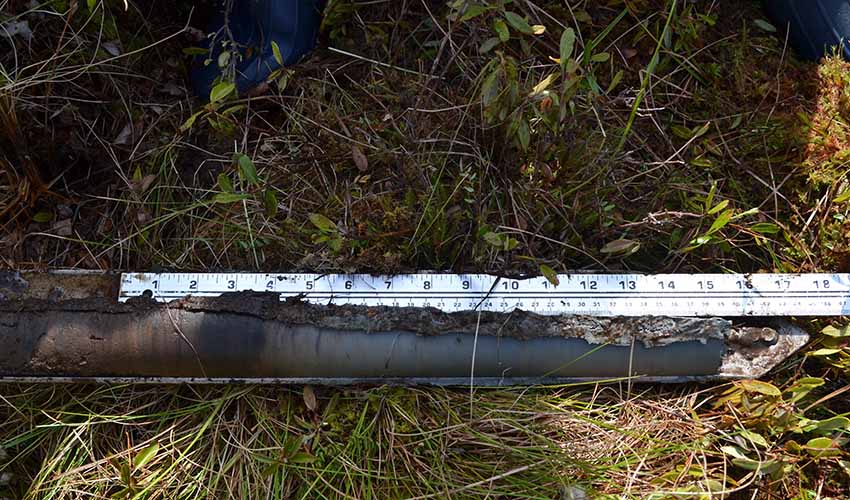MRU researcher contributes to study showing rapid destruction of biomass
Trees and other vegetation that took 10,000 years to form cut in half in 150
— Mount Royal University | Posted: August 5, 2022

Researchers measure a pollen core.
A research group including Mount Royal University mathematician Dr. Andria Dawson, PhD , has shed light on the destructive toll 150 years of deforestation has taken on a North American biomass (trees, other vegetation and their residue) that formed over 10,000 years.
Featured in the prestigious journal Science , the study concluded that contrary to what many researchers have assumed, forest biomass was not stable before industrialization, but grew due to increasing forest area after glaciers receded and because of changing tree species composition.
“In this work we reconstructed forest biomass from a network of fossil pollen records. These fossil pollen records are from sediment cores and tell us about how ecosystems have changed through time. A network of these cores allows us to say things about ecosystem change across space as well,” Dawson explains, and who is an assistant professor in MRU’s Department of General Education .
The study found that over the last 10,000 years, there was a steady accumulation of forest biomass, which almost doubled during the last 8,000 years. This slow and steady accumulation was a result of the increase in numbers of high-biomass trees and shifts in ecoregions (forest types) across the landscape.Major industrial-era land-use change and clearing of the land, however, halved this biomass in a mere 150 years.
“Forests store carbon. Some of the forests we cut down took millenia to get to their current state of carbon storage. This forest carbon accumulation process was slow and steady over the last 10,000 years. Then, with land clearance, half of this biomass was removed,” Dawson says.
The findings challenge the assumption that forests were in a steady state prior to the industrial era (an assumption, Dawson says, typically made by carbon cycle modellers). They also suggest benefits to managing sustainable forests with high-biomass trees as being one way to emulate these natural processes and store large amounts of carbon.

Dr. Andria Dawson, PhD, participated in a study on the slow buildup and rapid destruction of woody biomass.
Math plays a major part in ecological study
Dawson was involved with the study’s conceptual design and implementation as well as data processing and interpretation. In addition, she contributed to the writing and editing process.
“My research is broadly about understanding ecosystems and climate change across space and through time, typically over centennial to millennial timescales,” she says. “I do this using mathematical models informed by data, with a focus on being able to make inferences about these changes and characterize the uncertainty in our understanding. These models are informed by ecological data, primarily tree ring and fossil pollen data.”
Mathematics underpins much of our understanding about our world, Dawson stresses, but the way in which we teach mathematics doesn't make this connection.
“In fact, most ecologists use mathematics and statistics in their research. If you ask them if they wish they had taken more mathematics courses during their time at university, I suspect most would say ‘yes.’ Plus, studying mathematics is a great way to develop your problem-solving skills. Everyone solves all kinds of problems all the time in our daily lives, so why wouldn't we all take the opportunity to get better at it?”
Dawson also highlights that this research and the resulting interest shows students are not limited to pursuing opportunities only in the discipline they study.
“My degrees are in math, but I can almost pass as an ecologist now, at least I like to think so. Look for connections among your interests,” she suggests, “and forge your own path.”
The research was done as part of the PalEON (Paleo-Ecological Observatory Network) project, which was funded through a National Science Foundation Macrosystems grant. Lead researcher Dr. Ann Raiho, PhD , and Dawson both worked on (and were funded by) the PalEON project while Dawson was a postdoctoral scholar and Raiho was working on her PhD.
“This work would not be possible without all of the people who collected and counted the fossil pollen data,” Raiho said in a story published by the University of Maryland . “There were probably a hundred people over the last several decades who did all the field work. We used over 232 fossil pollen cores in this research. Thousands of hours went into the data collection. We used the Neotoma database to access this valuable data.”
In addition to Raiho and Dawson, the study included researchers from the University of Notre Dame; the University of California, Berkeley; the University of Calgary; and the U.S. Geological Survey. Jason McLachlan, an associate professor in paleoecology at the University of Notre Dame, is the primary investigator on the PalEON project.
“ Understanding the role that humans have played in altering forests over thousands of years is important in understanding the changes occurring in forests today, ” McLachlan says.
Elizabeth Blood, program director with the U.S. National Science Foundation, told the University of Maryland, “ These findings are essential in providing a baseline from which we can measure current change and monitor how forests are helping to capture carbon today. ”

